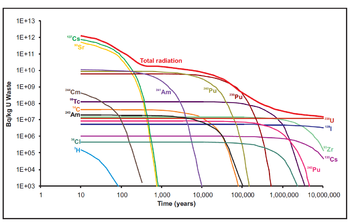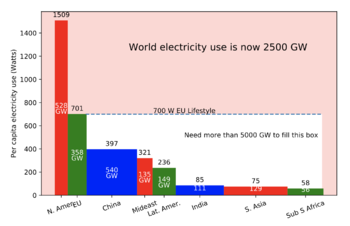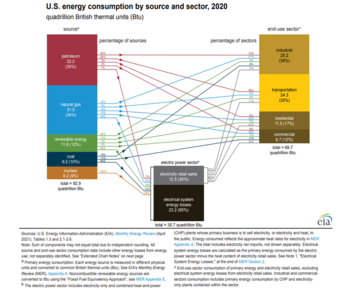User:David MacQuigg/Sandbox/Nuclear power reconsidered: Difference between revisions
imported>David MacQuigg No edit summary |
imported>David MacQuigg No edit summary |
||
| Line 1: | Line 1: | ||
{{TOC|right}} | {{TOC|right}} | ||
The threat of climate change from fossil fuels has led to a reconsideration of nuclear power as a source of carbon-free energy. Among the alternatives to fossil fuels, nuclear is unique in that it is not dependent on intermittent weather and can be deployed anywhere in the world. | The threat of climate change from fossil fuels has led to a reconsideration of nuclear power as a source of carbon-free energy. Among the alternatives to fossil fuels, nuclear is unique in that it is not dependent on intermittent weather and can be deployed anywhere in the world. | ||
{{Image|Consumption-by-source-and-sector.png|right|350px| | {{Image|World Electricity Consumption.png|right|350px|Future electricity consumption may double.}} | ||
{{Image|Consumption-by-source-and-sector.png|right|350px|Electricity is only one third of the CO2 problem. Nuclear might also provide process heat for industry and fuels for the transportation sector.}} | |||
The purpose of this article is to examine the issues that have held back widespread use of nuclear power. These issues include safety, waste management, weapons proliferation, and cost. Many new reactor designs have been proposed that seek to address these issues. We will try to establish objective criteria to evaluate these new designs and to facilitate public discussion on the question of what role should nuclear power play in the coming worldwide move away from fossil fuels. | The purpose of this article is to examine the issues that have held back widespread use of nuclear power. These issues include safety, waste management, weapons proliferation, and cost. Many new reactor designs have been proposed that seek to address these issues. We will try to establish objective criteria to evaluate these new designs and to facilitate public discussion on the question of what role should nuclear power play in the coming worldwide move away from fossil fuels. | ||
Revision as of 12:13, 21 September 2021
The threat of climate change from fossil fuels has led to a reconsideration of nuclear power as a source of carbon-free energy. Among the alternatives to fossil fuels, nuclear is unique in that it is not dependent on intermittent weather and can be deployed anywhere in the world.
The purpose of this article is to examine the issues that have held back widespread use of nuclear power. These issues include safety, waste management, weapons proliferation, and cost. Many new reactor designs have been proposed that seek to address these issues. We will try to establish objective criteria to evaluate these new designs and to facilitate public discussion on the question of what role should nuclear power play in the coming worldwide move away from fossil fuels.
It is essential that the review of any new design be done by people who have engineering experience, but are not connected to the nuclear industry or any political advocacy group. The review process should be transparent, with all arguments for and against, published for public comment.
Issues Confronting the Nuclear Industry
Safety
Widespread deployment of nuclear reactors will require the new designs to address not only the problems that have lead to accidents in the past, but also what might be conceivable in the future, including natural disasters and sabotage. Nuclear power over the last 50 years, when measured by objective criteria like number of deaths per terawatt hour of energy produced, has been safer than even natural gas (the safest of the fossil fuels), but not as safe as wind and solar. [1] The new designs will have to be even safer.
Nuclear accidents are like airplane crashes - in the public mind far more horrible than coal mine disasters or everyday car crashes. The public cannot tolerate another Three Mile Island. A new design must be "walk away safe" - that is, the ability to shut itself down even if the operators just walk away and do nothing to prevent an accident. Let's call this level of safety S-1. Beyond that, we could require S-2 - no way the operators (or terrorists) can cause a radiation leak by overriding the normal controls. Finally, let's call S-3 the highest level of safety - no way, even using explosives that terrorists could cause a leak. S-3 may be impossible to achieve. In that case, we must consider possible scenarios and our response.
Scenario Sab-1: Terrorists arrive with cable cutters, a hacksaw, and a memory stick with some malware from North Korea. The operators are expelled, except one, who is told that his daughter is held hostage, and will be killed if anything goes wrong with the terrorist plan.
Scenario Sab-2: The terrorists have heavy equipment to drill through concrete, and explosives to blow the reactor sky high.
Scenario Sab-3: The terrorists have tunneling equipment to come at the reactor from underground.
There may be dozens of scenarios to consider, including tsunamis, hijacked airplanes, and even a meteorite strike. The public should be encouraged, perhaps even rewarded for submitting scenarios worthy of consideration. The fall of the towers could have been prevented, if engineers had thought of a way to keep the steel from overheating.
Waste Management
How much waste is produced compared to other forms of energy? How will it be contained, and what are the dangers to people and the environment? Like questions on safety, public perception of the dangers of nuclear waste is much worse than historical data shows.[2] The volume of waste per per terawatt-hour is ____ times less than coal. Even if we look only at radioactivity released to the environment, coal ash is worse.[3]

Much of the worry about nuclear waste centers around the long life of the radioactivity from some of the isotopes in the waste (See Fig. 1). Even though most of this radioactivity decays in just a few years, there is concern about leakage into the environment decades or even centuries from now. Billion-dollar efforts to bury the waste deep under a mountain have only heightened public fears. Current "temporary" storage facilities have proven to be very safe and economical as long-term storage, and they have the advantage of being able to recycle the "waste" and use it in newer reactors that can burn the remaining 95% of available energy.
The remaining worries seem to be centered on the possibility of sabotage or theft of waste material that might be useful in a "dirty bomb". Again, we should evaluate any plans by considering likely scenarios. Is the storage facility near a population center and vulnerable to an airplane crash, a truck bomb or even a short-range missile? Is recovery of the spent fuel difficult enough that there will be plenty of time to stop a theft?
Weapons Proliferation
Will deployment of reactors to untrusted countries, or countries that might be taken over by rogue actors, increase the risk of proliferation, either by theft of materials in the reactor, or modification of the reactor to produce weapons-grade materials? There are three nuclides with potential for making a bomb: U-233, U-235, and Pu-239. Pressurized Water Reactors (PWR's) have a brief period in their fuel cycle where weapons-grade Pu-239 can be extracted from the partially burned fuel. Some thorium reactors with on-site fuel processing may be vulnerable to skimming of a small fraction of U-233 from the process loop. Uranium enriched to 20% U-235 in the initial fuel load, might provide a head-start to a country wanting to enrich all the way to bomb-grade.
Considerations like these favor designs in which all fuel processing is done at secure locations, and there is never any weapons grade material easily extracted from an operating reactor.
Cost
How will the cost compare to existing power sources including wind and solar? Existing nuclear plants have been very expensive, due to the inherent risks in pressurized water reactors (PWR's) and the need for expensive structures and burdensome regulations to deal with that risk. Newer designs promise to be much simpler, and manufactured on an assembly line, rather than site built. Elimination of water at high pressure and temperature avoids the risk of steam explosions. Cost is a less of worry than the other issues, because the risk can be born by private companies promising to deliver reactors at an agreed price.
One remaining worry is future costs if fuel or some essential material becomes scarce. Some PWR's require hafnium in their control rods, and there was worry about the world supply of hafnium if thousands of these reactors were to be deployed in the coming decades.[5] As for the cost of fuel, molten salt reactors don't require expensive fuel rods. They can burn thorium, which is three times more abundant than uranium, and some of them can even burn spent fuel from PWR's.
Proposed Designs
Here is a brief summary of each design. See the linked articles for a full discussion.
ThorCon
This is a molten salt reactor (MSR) using a mix of uranium and thorium in a fluoride salt with a graphite moderator.[6]
MCSFR
This is a molten chloride salt fast reactor with no moderator, capable of burning spent nuclear fuel and bomb cores.[7]
NuScale
This is a smaller version of a standard Pressurized Water Reactor (PWR). [8]
Natrium
A fast reactor using molten sodium as the coolant. Development funded by Bill Gates. Like the MCSFR, capable of burning spent nuclear fuel. [9]
References
- ↑ https://ourworldindata.org/safest-sources-of-energy
- ↑ worldindata
- ↑ nuclides in coal ash
- ↑ https://blogs.egu.eu/network/geosphere/2015/02/02/geopoll-what-should-we-do-with-radioactive-waste/
- ↑ Abbot
- ↑ https://thorconpower.com/docs/docs_v130_isle20190315.pdf
- ↑ https://www.youtube.com/watch?v=_ou_xswB2b0
- ↑ https://www.science.org/news/2019/02/smaller-safer-cheaper-one-company-aims-reinvent-nuclear-reactor-and-save-warming-planet
- ↑ https://natriumpower.com

